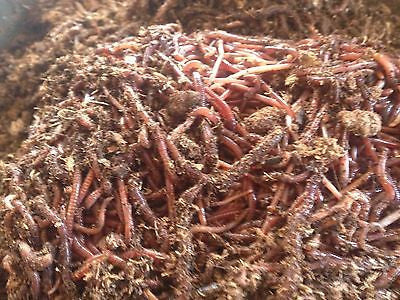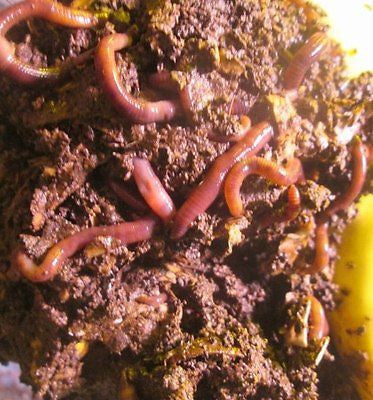Exactly How Red Wigglers Can Increase Your Organic Waste Recycling
Red wigglers stand for a pivotal component in improving organic waste recycling, effectively transforming everyday kitchen scraps and garden debris right into important worm spreadings. Comprehending the ins and outs of establishing a vermicomposting system and the optimum treatment for these worms can substantially intensify the benefits.

Advantages of Red Wigglers
Red wigglers, a type of composting earthworm, deal numerous benefits that make them vital in natural waste recycling. Their capability to eat a large variety of natural products makes them highly efficient decomposers. These worms can process kitchen area scraps, yard waste, and even paper products, changing them right into nutrient-rich spreadings. This procedure not only decreases the quantity of waste sent to land fills however also improves dirt wellness.
Moreover, red wigglers boost dirt aeration and drain via their burrowing tasks, advertising a healthier root environment for plants. Their castings are abundant in beneficial microbes and essential nutrients, promoting robust plant development and boosting dirt framework (red wigglers). In addition, using red wigglers in composting is an ecologically pleasant option to chemical fertilizers, which can have hazardous side effects.
Additionally, vermicomposting with red wigglers is a low-maintenance and effective approach of recycling natural waste, making it accessible for homes and areas alike. Their fast reproduction rate guarantees a constant supply for ongoing composting efforts, even more enhancing their advantages. Generally, red wigglers function as a crucial part in lasting waste administration and soil enhancement methods.
Setting Up a Vermicomposting System
Producing an efficient vermicomposting system needs cautious planning and consideration of different aspects that add to its success. The foundation of an effective system starts with picking a proper container. Choices range from business containers to homemade alternatives, but it is important that the container is well-ventilated and properly sized to fit the variety of red wigglers.
Following, the choice of bed linen product is crucial. Suitable bed linen includes shredded paper, cardboard, or coconut coir, which provides both an environment and a resource of carbon for the worms. The bed linens ought to be dampened yet not extremely wet to stop anaerobic conditions.
Keeping the optimum setting is vital. Red wigglers grow in temperature levels in between 55 ° F and 77 ° F(13 ° C to 25 ° C )and need a pH degree around neutral. Keeping track of dampness levels is also critical, as way too much moisture can lead to smell problems, while insufficient can dry out the worms.
Lastly, positioning the vermicomposting system in a shaded location safeguarded from straight sunshine will certainly aid preserve a stable setting. With these considerations in mind, one can effectively establish up a growing vermicomposting system that enhances natural waste recycling.
What to Feed Red Wigglers
Feeding red wigglers the best products is fundamental to preserving a healthy vermicomposting system. These worms prosper on a varied diet plan largely made up of raw material, that includes fruit and veggie scraps, coffee grounds, crushed eggshells, and shredded paper. It is essential to prevent feeding them meat, milk, oily foods, or any refined things, as these can develop odors, bring in pests, and cause an unhealthy environment.
A balanced diet regimen for red wigglers promotes optimal food digestion and nutrient production. Go for a mix of eco-friendly products, high in nitrogen, such as veggie peels and grass cuttings, and brownish products, abundant in carbon, like dried leaves and cardboard. This balance ensures a lasting food resource while keeping moisture levels in the worm bin.
Additionally, it is suggested to chop or shred larger scraps to speed up decay and make the food a lot more accessible to the worms. Consistently keeping track of the usage price will certainly assist establish the ideal amount to feed, preventing overfeeding and maintaining a thriving ecological community. By offering a suitable diet, you not only support the health of red wigglers but also enhance the efficiency of your vermicomposting initiatives.
Preserving Your Worm Bin
To make sure the health and performance of your vermicomposting system, preserving your worm container is vital. If it becomes also wet, excess wetness can lead to anaerobic conditions, hurting your worms.
Temperature is an additional vital variable. Ideally, the worm container should be maintained in between 55 ° F and 77 ° F(13 ° C to 25 ° C) Extreme temperature levels can stress or eliminate your worms. To attain this, place your container in a climate-controlled environment far from straight sunlight or warm resources.
Carefully transforming the bed linens with a yard fork every couple of weeks will certainly help aerate the material and stop compaction - red wigglers. If this takes place, decrease feeding and include even more carbon-rich materials like shredded paper or cardboard.
(red wiggler earthworms for sale)
Making Use Of Worm Castings in Horticulture

Worm spreadings, often referred to as "black gold" by garden enthusiasts, are a very nourishing natural plant food that can substantially boost soil health and plant growth. These spreadings are generated by red wigglers as they absorb organic matter, resulting in an abundant, dark, crunchy compound including advantageous microbes.
Including worm spreadings into garden soil enhances its structure, oygenation, and dampness retention, developing an ideal environment for origin advancement. The high nutrient web content of worm spreadings, click to read more including nitrogen, phosphorus, and potassium, adds to strenuous plant growth and increased returns. Furthermore, worm castings have necessary trace minerals and enzymes that promote the total health and wellness of plants, enabling them to much better endure pests and conditions.
Worm castings can be used directly to the soil or combined into potting blends for container gardening. A slim layer spread over garden beds or included to compost piles can also improve the microbial activity and nutrient profile of the compost. As a sustainable and green fertilizer alternative, worm castings sustain organic horticulture practices while reducing dependence on artificial fertilizers, therefore promoting a much healthier community.
Conclusion
Finally, the assimilation of red wigglers right into organic waste recycling techniques presents a sensible solution for improving dirt health and wellness and advertising sustainable horticulture methods. By efficiently breaking down kitchen scraps and yard waste, red wigglers add to nutrient-rich worm castings that enhance dirt aeration and dampness retention. This environmentally friendly technique not just reduces landfill payments but likewise lessens the dependancy on chemical fertilizers, eventually promoting much healthier ecosystems and accountable waste monitoring techniques.